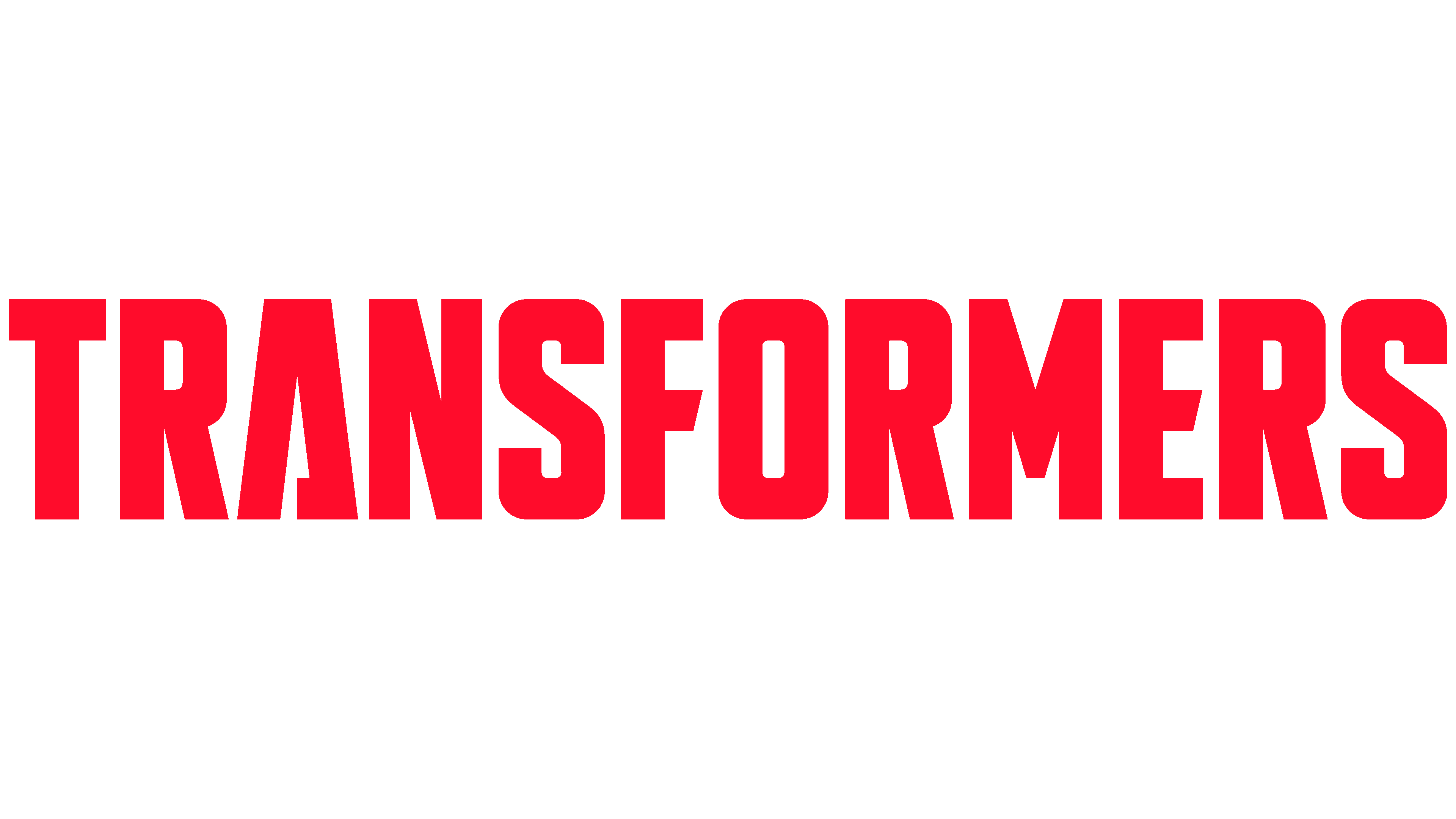Transformers Logo
“Transformers” is a popular multimedia franchise originating from a toy line by Hasbro and Takara Tomy in the 1980s. It centers on two robotic factions – the heroic Autobots and the villainous Decepticons – capable of transforming into vehicles, animals, and other objects. The saga, set against an intergalactic backdrop, delves into themes of war, loyalty, and identity. Over the years, “Transformers” has expanded into cartoons, movies, comics, and merchandise, with characters like Optimus Prime and Megatron becoming cultural icons. Its legacy is marked by thrilling battles, complex characters, and the timeless theme of good versus evil.
Meaning and history
The “Transformers” franchise began in the early 1980s as a collaboration between American toy manufacturer Hasbro and its Japanese counterpart, Takara Tomy. Both companies had their own transforming robot toy lines: Hasbro with the “Diaclone” and “Micro Change” series, and Takara with “Car Robots” and “Gun Robo”. Seeing potential in combining these lines, Hasbro launched the “Transformers” brand in 1984.
The basic premise revolved around two factions of alien robots: the noble Autobots, led by Optimus Prime, and the malevolent Decepticons, under the command of Megatron. These robots could transform into vehicles, weapons, and other items, offering play value beyond traditional action figures.
To promote the toy line, Hasbro partnered with Marvel Comics to create a backstory. Marvel’s Jim Shooter and Denny O’Neil crafted the narrative foundation, and Bob Budiansky further developed character names and profiles. The resulting comic series detailed the Transformers’ origins on the metallic planet Cybertron, their civil war, and their journey to Earth in search of energy sources.
Simultaneously, an animated television series produced by Sunbow and Marvel Productions aired. This series, with its memorable theme song and captivating story arcs, greatly boosted the toy line’s popularity. Iconic episodes introduced various characters and concepts, such as the Matrix of Leadership and the planet-eating robot, Unicron.
The franchise’s success led to an animated film in 1986, “Transformers: The Movie”, which took risks by killing off major characters and introducing new ones. Though initially a box-office disappointment, it later became a cult classic.
Over the years, “Transformers” underwent numerous reboots and iterations. The 1990s saw series like “Beast Wars” and “Beast Machines”, which introduced organic transformations. The early 2000s rejuvenated interest with series such as “Transformers: Armada”, “Energon”, and “Cybertron”.
A significant boost came in 2007 with Michael Bay’s live-action film, “Transformers”. Its massive commercial success spawned sequels, establishing a cinematic universe and attracting new fans.
Recent years have seen a return to classic G1 designs and characters, with series like “Transformers: Cyberverse” and “War for Cybertron”. Additionally, the franchise continues to grow through comics, video games, and conventions, celebrating its rich history and continued resonance with fans globally.
1984 – 1989
The initial emblem showcases a gradient blend of blue and red hues with a lustrous metallic touch. This sheen, coupled with the play of light and shadow on the borders of the alphabets, provides a tangible depth to the text. The brand name is split and presented on dual tiers: with “Trans” positioned leftward on the upper echelon, while “Formers” nestles beneath to its right. The upper layer intriguingly integrates an abstract symbol, reflecting the visage of a notable character. This motif carries the same blue-red gradient and metal-like finish consistent with other design features. The typography artfully contrasts uppercase letters with unconventional lowercase ‘n’ and ‘m’. The ‘A’ intriguingly omits its central beam, resembling the delta, a prominent character from the Greek script.
1989 – 1991
Following the revamp, the emblem eliminated its graphic symbol, giving way to a more simplified yet vibrant design. The split naming of the multimedia franchise remains, but with “Trans” directly atop “Formers.” The typeface adopted is a slanted sans serif. Notably, the “N” transitioned to uppercase, while the “m” retained its lowercase form, albeit with a stretched appearance. The “A” interestingly overlaps behind the “R.” Each character boasts a dual-tone black boundary. Furthermore, the lettering incorporates a tri-colored horizontal banding design in shades of red, white, and blue, adding vibrancy and depth to the overall composition.
1991 – 1993
In 1991, the logo underwent a transformation, gaining depth and a subtle shift in its color palette. The designers opted to omit the blue stripe from the brand name, retaining just the hues of red and white. Shadows, cast in black, were strategically introduced to the letters’ right and bottom edges, offering an illusion of them hovering over a backdrop. Meanwhile, the surrounding border, which has been refined to a slimmer and softer blue shade, stands out prominently because of the contrasting darker lines it juxtaposes with. This fresh approach breathed new life into the emblem, providing it with a more contemporary and three-dimensional feel.
1993 – 1999
The emblem has taken on a more vibrant tone: bold red characters encased in a sunlit yellow border. The inclination of the italics has been accentuated, causing the letters to lean more pronouncedly to the right. In addition, the iconic mask motif has made a reappearance. Contrasting the primary lettering, the mask radiates a golden yellow hue and is bordered by a fiery red outline. While the design continues to showcase shadowing effects, the stark black previously used has now been exchanged for a deep, rich maroon shade, infusing the logo with added depth and intensity. This revamped look provides a harmonious blend of nostalgia and fresh energy.
1999 – 2001
Following an extended phase where the term “Transformers” was divided, the design ultimately transitioned to a continuous format. The creative team opted to forgo the italicized style, instead choosing a bright citrus-yellow hue for the lettering. They introduced innovative tweaks to several characters by fusing parts of them together, as seen in the segments “RAN,” “ORM,” and “ERS.” Moreover, an added design element was the introduction of an arrow-like extension on the horizontal bar of the “T”, pointing towards the right, lending an air of dynamism and forward motion to the overall design. This revision brought a modern, cohesive feel, emphasizing unity and progression.
2001 – 2007
In the 2001 makeover, the visual persona of the media brand underwent a profound transformation, unveiling a blend of blue and black for its insignia. While maintaining its typographic essence, the logo incorporated ornate features into select characters. Notably, the “T” and “F” are emphasized with their larger stature and sharpened extremities, while the “R” and “S” cohesively intertwine at their bases through an elongated, sound wave-like ribbon. Set against a dark backdrop, the gradient blue word “Transformers” is encircled by a harmonizing blue contour that traces its shape. Further enriching the design, certain characters exhibit strategic notches, adding to the logo’s distinct flair.
2007 – 2014
In this era, the brand revisited its ancestral naming convention, eschewing the split and presenting its title on distinct lines. The rugged typography, intriguingly, lacks the traditional serifs often associated with such designs. Each character is framed with a dark border and seems to be forged from metallic slabs, yet these plates exhibit a muted, non-reflective finish. Additionally, certain letters deviate from the norm: the uppercase “A” evokes imagery of a pyramid or the delta symbol, while both “n” and “m” are stylized in a lowercase rendition, adding a unique twist to the ensemble.
2014 – Today
The revamped logo now radiates vivacity: the designers reintroduced the vibrant red hue while maintaining traditional letter designs. However, they chose to keep the distinct triangular structure for the “A,” devoid of a base. The subsequent characters showcase a shift in typography, adopting a more streamlined, uniform, and stretched-out style, lending a fresh perspective to the brand’s identity.



















